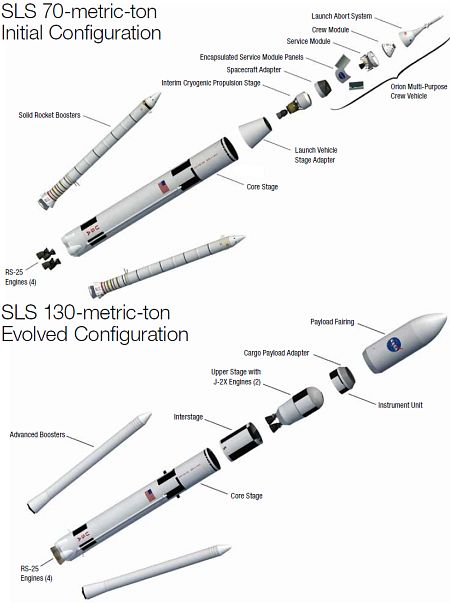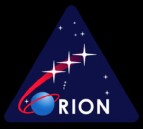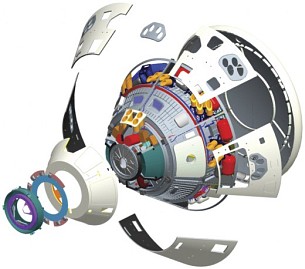|
|
| ||||||||||||||||||||||||||
Exploration is the name of the NASA directorate that has overall responsibility for developing new launch vehicles and spacecraft. Orion Spacecraft
The Lockheed Martin-built manned spacecraft component of the system, named the Orion Multi-Purpose Crew Vehicle (MPCV, formerly called the Crew Exploraton Vehicle, CEV), was originally intended to be operational by 2014 (with "boilerplate" tests by 2009 and unmanned flight tests of the actual vehicle by 2012), and to be capable of carrying astronauts to the moon by 2020. |
|
On April 10, 2009, NASA announced it had chosen Avcoat as the heat shield material for the Orion CEV. Avcoat is the same ablative material that was used for the Apollo spacecraft. Avcoat consists of silica fibers in an epoxy-novalic resin. It is filled into a fiberglass-phenolic honeycomb, which is manufactured directly onto the heat shield substructure, and attached as a unit to the spacecraft during assembly. Science Daily story On September 9, 2011, NASA announced that construction has begun on the first Orion MPCV orbital test article. The work is taking place at at NASA's Michoud Assembly Facility in New Orleans, utilizing friction stir welding. Friction stir welding, which was used to build the space shuttle external tanks at Michoud, creates seamless welds, stronger than those made by conventional welding. Frictional heat transforms the aluminum-lithium alloys structures of Orion to a plastic-like state. The seams are then stirred together under pressure to complete the weld. Heat shield installation and final assembly of the first orbital Orion will take place at Kennedy Space Center. NASA story |
Space Launch System (SLS) Launch Vehicles
The program to replace the current Space Shuttle system with new launch vehicles, another part of what was formerly called Project Constellation, was slowed and retitled by the Obama Administration, not wanting to implement a system identified with their predecessors. Now a very similar program is proceeding, called the Space Launch System, utilizing a Space Shuttle-derived inline heavy lift launch vehicle (HLV), a concept which is about 30 years old.The Space Launch System (SLS), in addition to the Orion Multi-Purpose Crew Vehicle, is to "carry cargo, equipment and science experiments to Earth orbit and beyond." The SLS will also serve as backup transportation to the International Space Station.
Early versions of the SLS are expected to carry up to 70 metric tons (over 154,000 pounds, 77 tons) to low Earth orbit (LEO). Later versions may carry up to 130 metric tons (286,000 pounds, 143 tons) to LEO. The SLS completed a combined System Requirements Review and System Definition Review on July 24, 2012. NASA story
The two-stage SLS will use four RS-25D/E engines (Space Shuttle Main Engine, SSME) from the Space Shuttle Program for the first stage. For the 70MT version, an "Interim Cryogenic Upper Stage" is being developed based on Boeing’s Delta Cryogenic Second Stage used on the Delta IV family of launch vehicles. This stage is powered by a single Pratt & Whitney RL-10B2 engine. The 130MT "Evolved" SLS will use two J-2X engines (an advanced version of the J-2 engine used in the Saturn V upper stages) for the second stage.
The RS-25D/E, RL-10B2, and the J-2X all use liquid hydrogen (LH2) as fuel and liquid oxygen (LOX) as oxidizer. The first stage propellant tank design will be derived from the Space Shuttle External Tank (ET).
SLS will use strap-on solid rocket boosters (identical to the previously planned Ares V SRBs) for the initial development flights, "while follow-on boosters will be competed based on performance requirements and affordability considerations."
The first SLS test flight is now targeted for the end of 2017. SLS Acquisition Overview 2011-09-22
NASA says: "This architecture provides a modular launch vehicle that can be configured for specific mission needs using a variation of common elements. NASA may not need to lift 130 metric tons for each mission and the flexibility of this modular architecture allows the agency to use different core stage, upper stage, and first-stage booster combinations to achieve the most efficient launch vehicle for the desired mission."
SLS Fun Facts (PDF)
Space Launch System & Orion MPCV Preliminary Report .pdf
Human Space Exploration Framework (HEFT) Summary
SLS, MPCV & 21CGS Independent Cost Assessment .pdf
Life Cycle Cost Analysis of Shuttle-Derived LVs, Volume 1 1982 .pdf
Shuttle-Derived Launch Vehicles' Capablities: An Overview 2005 .pdf
The Altair Lunar Surface Access Module (LSAM), a companion lunar lander craft (generally similar to the Apollo Lunar Module), and the Block 2 Orion was to provide transportation for a new lunar landing program with a total price of $104 billion. Now a Near-Earth Asteroid mission is more likely than a lunar landing, and vehicle "stack" configurations are still being considered.
The LSAM was to be fueled by liquid methane and LOX. If methane (requiring new development) was abandoned, the descent stage of the Altair would probably have used 4 Pratt & Whitney RL-10 engines, which burn liquid hydrogen (LH2) and liquid oxygen (LOX). The ascent stage of the Altair would have likely had a single engine, possibly a version of the Orion's hydrazine and nitrogen tetroxide engine, or possibly a single RL-10 engine (although this presents problems in keeping the LH2 liquid over long periods of time).
All 4 astronauts were to descend to the lunar surface while the Orion spacecraft orbited unattended, and eventually stay on the moon for as long as six months. Development of the Altair LSAM lunar lander was to be split between Marshall Space Flight Center and Goddard Space Flight Center.
Constellation Space Suit System
Space Shuttle EVA spacesuits are too heavy and stiff for use on the moon's surface (at 1/6 earth's gravity). On June 13, 2008, NASA announced that it had awarded a contract to develop new space suits for use by Orion astronauts to Houston, Texas-based Oceaneering International, Inc.The contract's intitial term, from June 2008 to September 2014, has a value of $183.8 million. During this time Oceaneering and subcontractors will develop and manufacture prototypes of a new space suit for launch, reentry, abort, and EVA (spacewalk) use. They will also begin development of a related new suit for lunar surface EVAs, which will share some modular components with the spacewalk suit.
Two options will likely be executed to extend the contract. Option 1, which would complete lunar EVA suit development and begin production, runs from October 2010 through September 2018 with a total value of $302.1 million. Option 2, which calls for Orion suit production, processing and sustaining engineering from October 2014 through September 2018, is worth up to $260 million. CSSS Contract Award Briefing 2.1MB .pdf
|
Space@QuickScitech:
NASA News |
Orion-SLS |
ISS |
Intl Progs-LVs |
Astronomy |
Mars Planets | Asteroids, Comets... | Shuttle | STS-107 | Apollo | NASA Subdomains |
NASA:SLS NASA Facts (June 2012)Orion Quick Facts Orion Spacecraft Overview Orion: Next Generation Spacecraft 50 page 4.7MB .pdf Project Orion Overview 725KB .pdf Orion Contract Images Project Constellation Overview 5.9MB .pdf NASA Exp. Sys. Arch. Study 758 page, 24.5 MB .pdf Chariots for Apollo 1979 online .html book B-II Apollo Ops Handbook Apr 1969 index to 16 .pdfs Apollo CSM Systems Sep 1967 9.7MB .pdf Skylab Apollo CSM Systems Apr 1972 11.1MB .pdf Apollo LM Familiarization 1965 8.8MB .pdf Apollo Lunar Module Orientation 1966 2.7MB .pdf Apollo LM Handbook Jun 1970 36.8MB .pdf Apollo Lunar Surface Journal Advanced Space Habitation 784KB .pdf Wikipedia:Orion - CEVApollo CSM Lunar Surface Access Module Apollo Lunar Module RL-10 Engine |
|
|
MISSIONS: NASA - ESA - JAXA |
|
KENNEDY SPACE CENTER: KSC Countdown Online - KSC Video Feeds webcams galore |
|
NASA TV LIVE - ISS TV |
|
POSTION TRACKING: ISS - ESA |
|
LAUNCH SCHEDULES: KSC - SpaceflightNow - Space Launch Report |
|
SPACE & ASTRONOMY: JPL Space Calendar |
|
KSC LAUNCH WEATHER: Spaceflight Meteo. Group: Launch Weather |
Orion NASA News
Space Shuttle Retirement and International Space Station Access
The Space Shuttles were retired in 2011. On September 21, 2005, Congress passed a bill allowing NASA to purchase Russian Soyuz spacecraft until 2012 to keep the International Space Station operating, and NASA has agreed to pay Russia's Federal Space Agency $719 million to carry 15 crew members to and from the ISS between 2009 and 2011.US Commercial Crew Vehicle
NASA's Commercial Crew and Cargo Program Office is currently funding the development of several competing commercial spacecraft which would be used to deliver crews and supplies to and from the International Space Station. NASA's own spacecraft, the Orion MPCV, is intended for use on missions to asteroids, the Moon, and possibly Mars, although it might be used on trips to the ISS if necessary.The SpaceX Dragon is a capsule-type spacecraft which they deliver atop their own Falcon 9 launch vehicle. SpaceX has said their manned spacecraft might be ready for use by 2014.
SpaceX already has a NASA Commercial Orbital Transportation Services (COTS) contract to resupply the International Space Station with a cargo-only version of Dragon. Dragon successfully completed its first ISS unmanned cargo mission in October, 2012.
The Boeing CST-100 (being developed in conjuction with Bigelow Aerospace) is a capsule-type spacecraft which would utilize an Atlas V launch vehicle. The CST-100 is expected to be operational by 2015.
Sierra Nevada Space Systems is developing a runway-landing spacecraft called the Dream Chaser, a lifting body based on the NASA HL-20 design. The Dream Chaser would also utilize an Atlas V launch vehicle, and is also expected to be ready by 2015.
Blue Origin, funded by Amazon.com founder Jeff Bezos, is developing a Single Stage to Orbit (SSTO) vertical take off and landing type vehicle (and crew capsule) called the New Shephard, which is similar to the McDonnell DC-X Delta Clipper. However, the vehicle currently under development is strictly suborbital, and thus of limited utility. The New Shephard is expected to be operational between 2016 and 2018.
ISS Commercial Resupply Services (CRS, aka COTS)
In August, 2006, NASA awarded Commercial Orbital Transportation Services (COTS) contracts to two companies: $278 million to SpaceX and $207 million to Rocketplane KistlerIn February, 2008, when Rocketplane Kistler failed to secure enough financing to meet contract obligations, the remainder of their part of the COTS contract was transferred to Orbital Sciences, a company which already has proven its capabilities with dozens of payloads launched to orbit.
The COTS program, the cost of which was about the same as a single Space Shuttle flight, called for the companies to demonstrate their capability to service the International Space Station (ISS) after the Space Shuttles was retired in 2011.
Hawthorne, California-based Space Exploration Technologies, aka SpaceX, founded in 2002 by PayPal cofounder Elon Musk, had 400 employees as of November, 2007. SpaceX is developing their Dragon spacecraft in both manned and unmanned versions to recrew and resupply the International Space Station.
SpaceX also has two launch vehicles, the Falcon 1 and the Falcon 9, both of which use LOX/kerosene burning engines. The Falcon 9 began lifting Dragon spacecraft on flights to the ISS in 2012.
The 4th test of the Falcon 1, with 364lb test payload, launched from the Reagan Test Site on Omelek Island, Kwajalein Atoll, on Sep 28, 2008, was a success, becoming the first privately developed launch vehicle ever to reach orbit (500 km by 700 km, 9.2 degrees inclination, "exactly as targeted"). press
Orbital Sciences has conducted over 50 space launch missions since 1990, using solid fueled vehicles.
For NASA's COTS program, Orbital intends to develop the medium-lift Taurus II solid-fueled launch vehicle, and a cargo spacecraft called Cygnus, using interchangeable modules for pressurized and unpressurized cargo. The Taurus II/Cygnus combo is to deliver up to 2,300 kg of cargo to the ISS, and return 1,200 kg of cargo to Earth. Taurus II/Cygnus artists renderings
Orbital's Pegasus XL, air-launched from an L-1011 aircraft at an altitude of about 40,000 feet, can carry satellites weighing up to 1,000 pounds to low earth orbit. Pegasus XL is a winged, three-stage, solid rocket booster that weighs approximately 23,130 kg (51,000 lbs), and measures 16.9 m (55.4 ft) in length and 1.27 m (50 in.) in diameter, and has a wing span of 6.7 m (22 ft). Pegasus fact sheet, .pdf
Orbital has also developed a ground-launched derivative of the Pegasus, called the Taurus. The four-stage Taurus can deliver a 1,350-kilogram (3,000-pound) satellite to low-Earth orbit. Taurus fact sheet, .pdf - Taurus user guide, .pdf
The Minotaur I utilizes a combination of decommissioned Minuteman II ICBM motors and Orbital's own stages and avionics.
Minotaur fact sheet, 1.9MB .pdf - Minotaur user guide, 6.6MB .pdf
Orbital is developing the Minotaur IV, which will use a combination of decommissioned Peacekeeper ICBM motors and Orbital's own stages and avionics. Minotaur IV fact sheet, 903KB .pdf - Minotaur IV user guide, 5.5MB .pdf
scitech.quickfound.net's
NASA Subdomains Search & Links page links to dozens of the numerous NASA subdomains, and includes two search engines, NASA advanced search and a customized version of Google, both of which you can use to search the NASA subdomains independently by copying the subdomain name (using ctrl-c) and pasting it (using ctrl-v) into the appropriate place on the forms (which are at the bottom of the page).
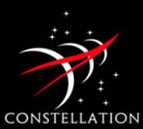
|
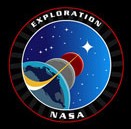
|
